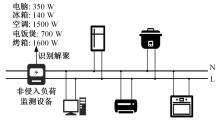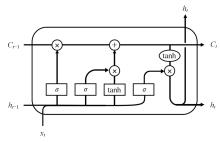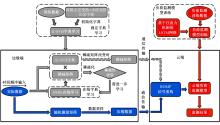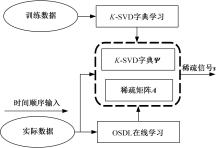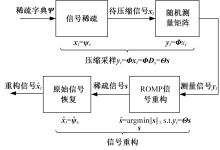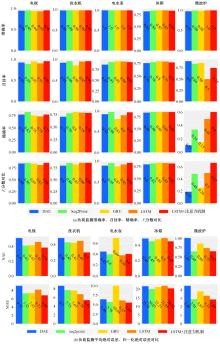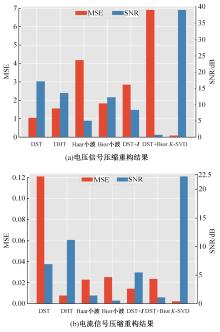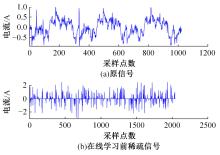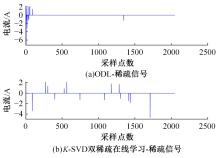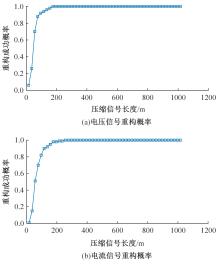吉林大学学报(工学版) ›› 2024, Vol. 54 ›› Issue (6): 1796-1806.doi: 10.13229/j.cnki.jdxbgxb.20220927
• 通信与控制工程 • 上一篇
基于在线压缩重构的非侵入式电力负荷监测
- 吉林大学 通信工程学院,长春 130012
Non-intrusive load monitoring via online compression and reconstruction
Qiu-zhan ZHOU( ),Ze-yu JI,Cong WANG(
),Ze-yu JI,Cong WANG( ),Jing RONG
),Jing RONG
- College of Communication Engineering,Jilin University,Changchun 130012,China
摘要:
对家庭场景下电力负荷的精确监测常依赖复杂庞大的算法模型,难以在边缘设备中部署。同时,海量电力数据给电力网络通信带来了巨大的挑战。本文针对以上问题,提出了一种分布式非侵入式电力负荷监测方法。通过基于注意力机制的长短时记忆网络(LSTM)负荷监测算法计算并识别负荷设备运行状态,借助云边协同技术将负荷监测任务分布式部署于云端以及边缘端中,解决边缘算力不足的问题。针对云边通信带来的高网络带宽需求,通过基于K奇异值分解(K-SVD)双稀疏在线字典学习的压缩感知方法对负荷信号进行压缩和重构,有效缓解通信资源紧张。对比不同负荷场景下监测算法的表现,结果表明:本文负荷监测算法针对不同的负荷类型均可以保持95%以上的准确率。设计实验验证了本文压缩感知方法对电力负荷信号压缩的有效性,确定负荷数据无失真压缩感知最大压缩比。
中图分类号:
- TP274
| 1 | Gillis J M, Chung J A, Morsi W G. Designing new orthogonal high-order wavelets for nonintrusive load monitoring[J]. IEEE Transactions on Industrial Electronics, 2018, 65(3): 2578-2589. |
| 2 | Wang A L, Chen B X, Wang C G, et al. Non-intrusive load monitoring algorithm based on features of V⁃I trajectory[J]. Electric Power Systems Research, 2018, 157: 134-144. |
| 3 | Hart G W. Nonintrusive appliance load monitoring[J]. Proceedings of the IEEE, 1992, 80(12): 1870-1891. |
| 4 | 张露. 非侵入式负荷监测算法研究[D].广州: 华南理工大学电力学院, 2019. |
| Zhang Lu. Research on non-intrusive load monitoring algorithms[D]. Guangzhou: School of Electrial Power Engineering, South China University of Technology, 2019 | |
| 5 | 刘博. 非侵入式电力负荷监测与分解技术[D].天津:天津大学电气与自动化工程学院, 2014. |
| Liu Bo. Non-intrusive power load monitoring and disaggregation technique[D].Tianjin: School of Electrial Information Engineering, Tianjin University, 2014 | |
| 6 | Hassan T, Javed F, Arshad N. An empirical investigation of V-I trajectory based load signatures for non-intrusive load monitoring[J]. IEEE Transactions on Smart Grid, 2014, 5(2): 870-878. |
| 7 | Tsai M S, Lin Y H. Modern development of an adaptive non-intrusive appliance load monitoring system in electricity energy conservation[J]. Applied Energy, 2012, 96: 55-73. |
| 8 | Batra N, Kelly J, Parson O, et al. NILMTK: an open source toolkit for non-intrusive load monitoring[C]∥e-Energy 2014-Proceedings of the 5th ACM International Conference on Future Energy Systems.New York,USA : Association for Computing Machinery, 2014: 265-276. |
| 9 | 王轲, 钟海旺, 余南鹏, 等. 基于seq2seq和Attention机制的居民用户非侵入式负荷分解[J] .中国电机工程学报, 2019, 39(1): 75-83, 322. |
| Wang Ke, Zhong Hai-wang, Yu Nan-peng, et al. Nonintrusive load monitoring based on sequence-to- sequence model with attention mechanism[J]. Proceedings of the CSEE, 2019, 39(1): 75-83, 322. | |
| 10 | Yue Z, Witzig C R, Jorde D, et al. BERT4NILM: a bidirectional transformer model for non-intrusive load monitoring[C]∥NILM 2020-Proceedings of the 5th International Workshop on Non-Intrusive Load Monitoring.New York,USA :Association for Computing Machinery, 2020: 89-93. |
| 11 | 凌家源. 基于事件检测与深度学习的非侵入式负荷监测算法[D]. 杭州: 浙江大学电气工程学院, 2021. |
| Ling Jia-yuan. Non-intrusive load monitoring based on event detection and deep learning[D].Hangzhou: College of Electrical Engineering, Zhejiang University, 2021. | |
| 12 | Sun Y, Cui C, Lu J, et al. Data compression and reconstruction of smart grid customers based on compressed sensing theory[J]. International Journal of Electrical Power and Energy Systems, 2016, 83: 21-25. |
| 13 | Saavedra E, Mascaraque L, Calderon G, et al. The smart meter challenge: feasibility of autonomous indoor iot devices depending on its energy harvesting source and iot wireless technology[J]. Sensors, 2021, 21(22). |
| 14 | 周学斌. 智能电网海量数据轻型化方法研究[D].武汉: 武汉大学电气与自动化学院, 2020. |
| Zhou Xue-bin. Research on the method of light massive data in smart grid[D].Wuhan: School of Electrical Engineering and Automation, Wuhan University, 2020. | |
| 15 | 王大伟, 崔国宇, 庞振江, 等. 边缘计算在多芯模组化电能表中的应用研究[J]. 单片机与嵌入式系统应用, 2019, 19(4): 30-33, 37. |
| Wang Da-wei, Cui Guo-yu, Pang Zhen-jiang, et al. Application research of edge computing in multi-core modular energy meter[J]. Microcontrollers & Embedded Systems, 2019, 19(4): 30-33, 37. | |
| 16 | Donoho D L. Compressed sensing[J]. IEEE Transactions on Information Theory, 2006, 52(4): 1289-1306. |
| 17 | Candes E J, Tao T. Near-optimal signal recovery from random projections: universal encoding strategies?[J]. IEEE Transactions on Information Theory, 2006, 52(12): 5406-5425. |
| 18 | Bao K, Ibrahimov K, Wagner M, et al. Enhancing neural non-intrusive load monitoring with generative adversarial networks[J]. Energy Informatics, 2018, 1(): 295-302. |
| 19 | Linh N V, Arboleya P. Deep learning application to non-intrusive load monitoring[J]. 2019 IEEE Milan PowerTech, 2019, 2019: 2-6. |
| 20 | Vinay M B, Rekha K S. A model of saliency-based visual attention for rapid scene analysis[J]. International Journal of Recent Technology and Engineering, 2019, 7(6): 412-415. |
| 21 | Liu G, Guo J. Bidirectional LSTM with attention mechanism and convolutional layer for text classification[J]. Neurocomputing, 2019, 337: 325-338. |
| 22 | Woo S, Park J, Lee J Y, et al. Cbam: Convolutional block attention module[C]∥Proceedings of the European conference on computer vision (ECCV),Copenhagen, Denmark, 2018: 3-19. |
| 23 | Rubinstein R, Zibulevsky M, Elad M. Double sparsity: learning sparse dictionaries for sparse signal approximation[J]. IEEE Transactions on Signal Processing, 2010, 58(3): 1553-1564. |
| 24 | Mazumder R, Friedman J H, Hastie T. SparseNet: coordinate descent with nonconvex penalties[J]. Journal of the American Statistical Association, 2011, 106(495): 1125-1138. |
| 25 | Engan K, Aase S O, Husoy J H. Method of optimal directions for frame design[J]∥IEEE International Conference on Acoustics, Speech and Signal Processing-Proceedings, Piscetawar NJ: IEEE, 1999, 5: 2443-2446. |
| 26 | Aharon M, Elad M, Bruckstein A. K-SVD: an algorithm for designing overcomplete dictionaries for sparse representation[J]. IEEE Transactions on Signal Processing, 2006, 54(11): 4311-4322. |
| 27 | Lu C, Shi J, Jia J. Online robust dictionary learning[C]∥Proceedings of the IEEE Computer Society Conference on Computer Vision and Pattern Recognition,Portland,USA, 2013: 415-422. |
| 28 | Mairal J, Bach F, Ponce J, et al. Online learning for matrix factorization and sparse coding[J]. Journal of Machine Learning Research, 2010, 11: 19-60. |
| 29 | Labusch K, Barth E, Martinetz T. Robust and fast learning of sparse codes with stochastic gradient descent[J]. IEEE Journal on Selected Topics in Signal Processing, 2011, 5(5): 1048-1060. |
| 30 | Sulam J, Ophir B, Zibulevsky M, et al. Trainlets: dictionary learning in high dimensions[J]. IEEE Transactions on Signal Processing, 2016, 64(12): 3180-3193. |
| 31 | Huang K, Wu Y, Long C, et al. Adaptive process monitoring via online dictionary learning and its industrial application[J]. ISA Transactions, 2021, 114: 399-412. |
| 32 | Tropp J A, Gilbert A C. Signal recovery from random measurements via orthogonal matching pursuit[J]. IEEE Transactions on Information Theory, 2007, 53(12): 4655-4666. |
| 33 | Blumensath T, Davies M E. Iterative thresholding for saparse approximations[J]. Journal of Fourier Analysis and Applications, 2008, 14(5/6): 629-654. |
| 34 | Baraniuk R, Davenport M, DeVore R, et al. A simple proof of the restricted isometry property for random matrices[J]. Constructive Approximation, 2008, 28(3): 253-263. |
| 35 | Baraniuk R G. Compressive sensing[J]. IEEE Signal Processing Magazine, 2007, 24(4): 118-121. |
| 36 | Candes E J, Tao T. Decoding by linear programming[J]. IEEE Transactions on Information Theory, 2005, 51(12): 4203-4215. |
| 37 | Donoho D L. For most large underdetermined systems of linear equations the minimal ℓ1-norm solution is also the sparsest solution[J]. Communications on Pure and Applied Mathematics, 2006, 59(6): 797-829. |
| 38 | Needell D, Vershynin R. Uniform uncertainty principle and signal recovery via regularized orthogonal matching pursuit[J]. Foundations of Computational Mathematics, 2009, 9(3): 317-334. |
| 39 | 石光明, 刘丹华, 高大化, 等. 压缩感知理论及其研究进展[J]. 电子学报, 2009, 37(5): 1070-1081. |
| Shi Guang-ming, Liu Dan-hua, Gao Da-hua, et al. Advances in theory and application of compressed sensing[J]. Acta Electronica Sinica, 2009, 37(5): 1070-1081. | |
| 40 | Kelly J, Knottenbelt W. The UK-DALE dataset, domestic appliance-level electricity demand and whole-house demand from five UK homes[J]. Scientific Data, 2015, 2: 1-14. |
| 41 | Shalev-Shwartz S. Online learning and online convex optimization[J]. Foundations and Trends in Machine Learning, 2011, 4(2): 107-194. |
| 42 | Hoyer P O. Non-negative matrix factorization with sparseness constraints[J]. Journal of Machine Learning Research, 2004, 5: 1457-1469. |
| [1] | 吴飞,农皓业,马晨浩. 基于粒子群优化算法⁃长短时记忆模型的刀具磨损预测方法[J]. 吉林大学学报(工学版), 2023, 53(4): 989-997. |
| [2] | 周求湛,冀泽宇,王聪,胡继康,李明明,陈禹竺,周险峰,刘萍萍. 基于猫群算法的震动感知周界安防系统[J]. 吉林大学学报(工学版), 2023, 53(4): 1187-1199. |
| [3] | 刘嫣然,孟庆瑜,郭洪艳,李嘉霖. 图注意力模式下融合高精地图的周车轨迹预测[J]. 吉林大学学报(工学版), 2023, 53(3): 792-801. |
| [4] | 曾春艳,严康,王志锋,王正辉. 多尺度生成对抗网络下图像压缩感知重建算法[J]. 吉林大学学报(工学版), 2023, 53(10): 2923-2931. |
| [5] | 孙洪亮,沈伟达,陈玲玲. 时延QoS约束下的混合业务带宽补偿算法[J]. 吉林大学学报(工学版), 2022, 52(8): 1912-1917. |
| [6] | 陈建,于帆,林琳,孙铭会. 基于多阵列合成孔径的局部超声阵列聚焦方法[J]. 吉林大学学报(工学版), 2022, 52(10): 2447-2455. |
| [7] | 窦慧晶,丁钢,高佳,梁霄. 基于压缩感知理论的宽带信号波达方向估计[J]. 吉林大学学报(工学版), 2021, 51(6): 2237-2245. |
| [8] | 刘洲洲,张倩昀,马新华,彭寒. 基于优化离散差分进化算法的压缩感知信号重构[J]. 吉林大学学报(工学版), 2021, 51(6): 2246-2252. |
| [9] | 侯春萍,赵春月,王致芃,田海瑞. 基于有效异常样本构造的视频异常检测算法[J]. 吉林大学学报(工学版), 2021, 51(5): 1823-1829. |
| [10] | 王义君,张有旭,缪瑞新,豆佳敏. 5G中基于系统中断概率的D2D资源分配算法[J]. 吉林大学学报(工学版), 2021, 51(1): 331-339. |
| [11] | 金心宇,谢慕寒,孙斌. 基于半张量积压缩感知的粮情信息采集[J]. 吉林大学学报(工学版), 2021, 51(1): 379-385. |
| [12] | 胡钊政,李招康,陶倩文. 基于分布式二维激光测距仪的室内行人检测与跟踪[J]. 吉林大学学报(工学版), 2020, 50(2): 719-729. |
| [13] | 赵鹏,蒋宇中,陈斌,李春腾,张杨勇. 基于局部方差域自适应Blanking的超低频信道噪声抑制方法[J]. 吉林大学学报(工学版), 2019, 49(5): 1696-1705. |
| [14] | 单泽彪,刘小松,史红伟,王春阳,石要武. 动态压缩感知波达方向跟踪算法[J]. 吉林大学学报(工学版), 2018, 48(6): 1938-1944. |
| [15] | 刘洲洲, 王福豹. 改进的离散混合蛙跳算法压缩感知信号重构及应用[J]. 吉林大学学报(工学版), 2016, 46(4): 1261-1268. |
|
||
